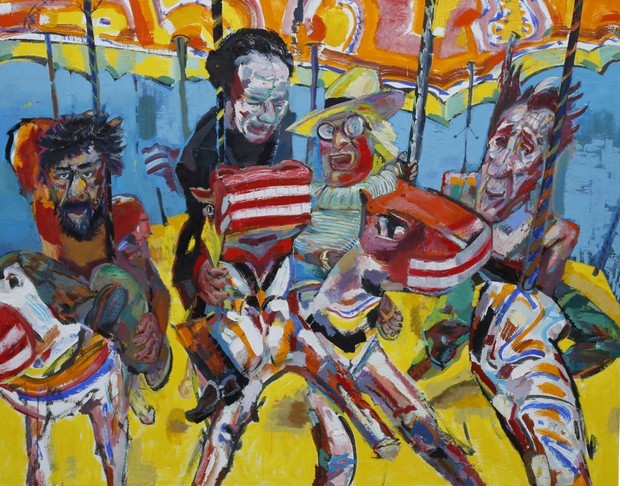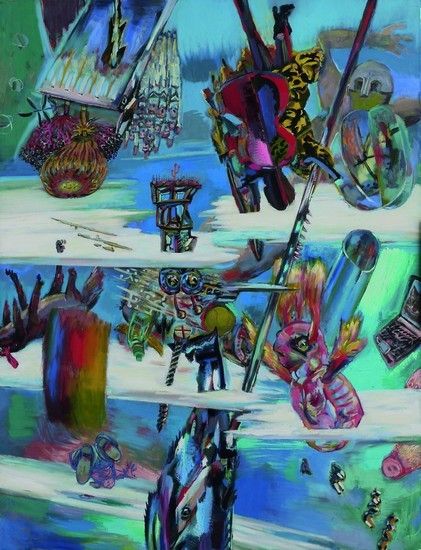Sighard Gille
Restless
30 Oct 2016 - 22 Jan 2017

Sighard Gille, Brigadefeier 1977, aus Brigadefeier-Gerüstbauer (Diptychon) 1975 - 77 © VG Bild-Kunst Bonn, 2016
SIGHARD GILLE
Restless
30 October 2016 - 22 January 2017
The Leipzig Museum of Fine Arts Leipzig will proudly present the first comprehensive retrospective on the painted oeuvre of Sighard Gille (*1941 Eilenburg) in autumn 2016. It will show around seventy paintings extending from the late 1960s to the present day. The complete catalogue raisonné of his paintings will be published on the occasion of the exhibition.
The exhibition will focus on Gille’s artistic output during the GDR period, in which the artist portrayed everyday life in a socialist society with the attitude of a sensitive yet ironic commentator. Gille quickly set himself apart from many of his older and younger colleagues in Leipzig by his refusal to select a heroic, glorifying narrative, turning his attention instead to the significant irrelevancies and public displays of intimacy which the ideological overload otherwise stripped from its subjects. This tendency is clearly apparent in what is perhaps his most famous work from this period, ‘The Brigade Celebration’ of 1977, which prompted an outcry from the powers that be, and also in his most important commissioned piece, the large-format ceiling painting, ‘The Song of Life’, for the Gewandhaus in Leipzig. The exhibition will also provide clear insight into Gille’s work after the reunification of Germany, when the artist was appointed Professor at the Academy of Fine Arts, and as a teacher also contributes significantly to the development of contemporary art in Leipzig. Gille’s oeuvre during this period is dominated by private topics, portraits, nudes and ironic reflections on everyday situations. Artistic musings on the political and social transformation also feature heavily in this phase. Eros comes to the forefront of his work as a driving force behind human intercourse. Moreover, the artist has opened up to a sensitive form of outdoor painting in recent years, turning to the landscape as a place to ponder the human condition.
His artistic experiments with photography and various printing techniques aside, the focus of Sighard Gille’s work has always been on a style of painting based on precise observation and studies of nature. His brilliant application of paint and his exuberant compositions reveal Gille to be a master of illustrative painting. Applying expressive articulation and gentle irony, the painter questions art on its relationship with life. After all, whatever the societal form and political constellation may be, Gille’s overarching topic remains focused on individuals and their inherent humanity.
Edited by Ina Gille, the catalogue and its introduction by Uwe M. Schneede will provide insight into how Gille influenced painting in Leipzig, and will hence become an important foundation for future research into post-1945 art in Leipzig.
Restless
30 October 2016 - 22 January 2017
The Leipzig Museum of Fine Arts Leipzig will proudly present the first comprehensive retrospective on the painted oeuvre of Sighard Gille (*1941 Eilenburg) in autumn 2016. It will show around seventy paintings extending from the late 1960s to the present day. The complete catalogue raisonné of his paintings will be published on the occasion of the exhibition.
The exhibition will focus on Gille’s artistic output during the GDR period, in which the artist portrayed everyday life in a socialist society with the attitude of a sensitive yet ironic commentator. Gille quickly set himself apart from many of his older and younger colleagues in Leipzig by his refusal to select a heroic, glorifying narrative, turning his attention instead to the significant irrelevancies and public displays of intimacy which the ideological overload otherwise stripped from its subjects. This tendency is clearly apparent in what is perhaps his most famous work from this period, ‘The Brigade Celebration’ of 1977, which prompted an outcry from the powers that be, and also in his most important commissioned piece, the large-format ceiling painting, ‘The Song of Life’, for the Gewandhaus in Leipzig. The exhibition will also provide clear insight into Gille’s work after the reunification of Germany, when the artist was appointed Professor at the Academy of Fine Arts, and as a teacher also contributes significantly to the development of contemporary art in Leipzig. Gille’s oeuvre during this period is dominated by private topics, portraits, nudes and ironic reflections on everyday situations. Artistic musings on the political and social transformation also feature heavily in this phase. Eros comes to the forefront of his work as a driving force behind human intercourse. Moreover, the artist has opened up to a sensitive form of outdoor painting in recent years, turning to the landscape as a place to ponder the human condition.
His artistic experiments with photography and various printing techniques aside, the focus of Sighard Gille’s work has always been on a style of painting based on precise observation and studies of nature. His brilliant application of paint and his exuberant compositions reveal Gille to be a master of illustrative painting. Applying expressive articulation and gentle irony, the painter questions art on its relationship with life. After all, whatever the societal form and political constellation may be, Gille’s overarching topic remains focused on individuals and their inherent humanity.
Edited by Ina Gille, the catalogue and its introduction by Uwe M. Schneede will provide insight into how Gille influenced painting in Leipzig, and will hence become an important foundation for future research into post-1945 art in Leipzig.


